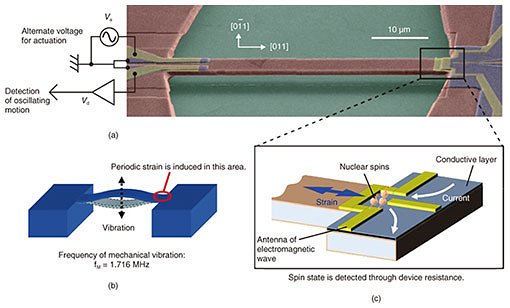 |
|||
|
|
|||
|
Short Reports Vol. 17, No. 2, pp. 81–83, Feb. 2019. https://doi.org/10.53829/ntr201902sr1 Controlling Nuclear Magnetic Resonance with a Micromechanical Oscillator—A Novel Technique to Individually Manipulate Nuclear Spins in Integrated Devices1. IntroductionNTT and the National Institute of Advanced Industrial Science and Technology (AIST) have developed a novel device technology to control solid-state nuclear magnetic resonance (NMR) with a micromechanical oscillator. Quantum memory has received much attention in recent quantum technology research for applications to quantum computers, quantum communications, and quantum sensors. Quantum computers are expected to perform ultrafast computation, while quantum communications can provide absolutely secure communications protocols, and quantum sensors promise to drastically improve sensor performance. Quantum memory’s ability to store quantum superposition states for a long period of time could improve the performance of these quantum technologies. One of the most important candidates for quantum memory is nuclear spin because of its extremely long spin lifetime. NTT and AIST experimentally demonstrated that the NMR frequency in a mechanical oscillator can be controlled by strain induced by its mechanical motion. This method enables us to control the quantum state of a nuclear spin in a desired mechanical element in an integrated array and will play an essential role in the development of solid-state-based quantum memory. This demonstration was made possible through a collaboration between NTT, which performed device fabrication and measurements, and AIST, which performed data analysis based on precise theoretical modeling. The results were published in Nature Communications on August 28, 2018 [1]. This work was partly supported by a Grant-in-Aid for Scientific Research on Innovative Areas (KAKENHI) from the Japan Society for the Promotion of Science, specifically by the research project of Science of Hybrid Quantum Systems. 2. Research backgroundNuclear spin is the rotation of an atomic nucleus, and it shows a precessional motion under a magnetic field. Nuclear spin can sustain precessional motion for a long period of time and is expected to be used in various applications such as quantum memory to store a quantum superposition state and high-performance magnetic field sensors. NMR is generally used to manipulate the nuclear spin state, where an electromagnetic wave at the NMR frequency is applied under a magnetic field to modify the precessional motion. However, it is hard to use standard NMR techniques for integrated devices because the magnetic field and electromagnetic wave are simultaneously applied to all the devices. Therefore, a novel method to manipulate nuclear spins in individual devices is in high demand. 3. Research resultsThe NMR frequency is highly sensitive to the strain applied in a solid, and this property was used to locally manipulate nuclear spins in this experiment. Artificially generating strain at a desired position in a material allows the control of NMR in individual integrated devices. A micromechanical oscillator fabricated using state-of-the-art nanofabrication technology was used to locally generate large strain, and the NMR frequency was controlled with oscillating strain using the resonator’s mechanical motion. As a result, we observed not only the modulation of the NMR frequency but also a novel kind of NMR called sideband resonance, which were induced by the mixed effect of electromagnetic waves and oscillating strain. 4. Experimental detailsThe mechanical oscillator (Fig. 1(a)) has the shape of a doubly clamped beam and was fabricated by processing GaAs (gallium arsenide), which is a piezoelectric semiconductor. The mechanical oscillation can be electrically induced through the piezoelectric effect. The motion generates periodic strain at the clamping point (Fig. 1(b)) and modifies the dynamics of nuclear spins in the strained region. In the experiments, we observed not only a shift in the NMR frequency but also sideband resonances, where the resonance was also confirmed at two shifted frequencies: blue- and red-detuned from the original NMR frequency. The theoretical calculation factored in the effect of oscillating strain on nuclear spin dynamics and showed good agreement with the experimental results, proving that the observed phenomenon can be well explained by the effect of mechanical oscillation.
5. OutlookThe mechanical oscillators are fabricated using semiconductor nanofabrication technology and can be integrated on a tiny semiconductor chip. We can utilize this scheme as a novel platform to integrate quantum memories and sensors by demonstrating nuclear spin control in individual arrayed devices. Reference
For InquiriesPublic Relations, NTT Science and Core Technology Group |
|||









